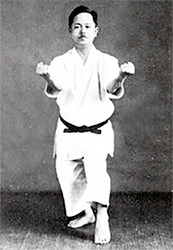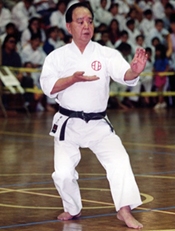International Shuriway Karate & Kobudo Society
 KATA 型 (Forms)
KATA 型 (Forms)

Kata, in Japanese, means ‘form’.
Practice of ‘kata’ or the correct forms and postures constitute an integral part of martial arts training, especially those originating from Okinawa.
Despite being a huge part of Japanese martial arts and culture, kata originally draws its roots from China. In ancient times, masters or practitioners of Chinese Kung Fu found it difficult to illustrate the techniques, both offensive and defensive, through words or paintings.
So instead, they developed the ‘forms’ or kata, highly-detailed movements consisting of dozens of micro-sequences, including, punches, kicks, blocks, footwork and breathing techniques, aimed to carefully archive their martial arts techniques and to pass it on to future generations.
Late in the 14th century, when the Ming dynasty sent several Chinese families from the Fujian province to settle on the Ryukyu islands, present-day Okinawa, they brought their kata with them.
Kata was an important component in the exchange of cultures amongst the locals and the immigrant Chinese families.

In what was an amalgamation of the Chinese martial arts forms, particularly Fujian Kung Fu, acquired through kata and the pre-existing local Ryukyuan hand-to-hand fighting technique over many years, a new martial arts style called Te or Tode was formed, which would later become known as karate.
Kata continued to be the chief form of knowledge transfer in karate and till the 1930s, it was the only way traditional masters taught the martial arts discipline.
There are many different views on what kata is. Kata has been said to be the soul of karate, a source of forgotten 'secrets', a form of moving mediation, a 'record' of the combative techniques, a pointless dance, or an archaic relic that should be abandoned.
To my way of thinking kata can be all those things and all those views can have merit. Essentially it comes down to the background of the individual martial artist and their experience of kata.
Kenwa Mabuni one of the foremost masters of the time, who was a historical collector and teacher of kata said; "In karate, the most important thing is kata. Into the kata of karate are woven every manner of attack and defense technique. Therefore, kata must be practiced properly, with a good understanding of their bunkai meaning."
Kata were predominately created to record the fighting methods of a given individual, the karate 'styles' of the time. Created to protect oneself from a civilian attack, self-defense or self-protection of the time, and of course it has the same value today.
Kata is also practiced as a physical solo template, consisting of combative motions, created to record the key principles of a given fighting system, so that those principles can be passed on to subsequent generations. Kata is a detailed pattern of movement which forms a complete fighting system.

Many Kata have been handed down by masters from previous generations and is therefore important that we practice and recreate these Kata in their original form.
Gichin Funakoshi, considered to be the father of modern day karate, his 18th precept of karate was; "Kata must always be performed exactly; Combat is another matter". In Genwa Nakasone's explanations of that precept - which Funakoshi endorsed - he states; "In actual combat it will not do to be shackled by the rituals of kata. Instead, the practitioner should transcend kata, moving freely according to the opponent's strengths and weakness".
To summarize: kata is a record of combative principles. To effectively make use of those combative principles we need to move beyond the solo form to practice the techniques with a partner (in a realistic fashion), so that we can internalize the underlying concepts and then freely express those concepts in sparring and in combat.
Traditional karate practitioners believe mastery of kata, is essential, mastery of karate.
With thanks to Iain Abernethy
